Author: Jason Cipriani
Traditionally, wort was hopped at 3 points during the boil– early on for bitterness, about halfway through for flavor, and toward the end for aroma. As the love for all things hoppy began to grow, brewers began dropping in larger aroma additions to amplify the aromatic qualities of their beer, particularly for styles like IPA and Pale Ale.
Up until a few years ago, such hop-forward styles were still known for possessing a certain degree of bitterness, though it would seem the skyrocketing popularity of New England IPA and led to an evolution of drinkers’ preferences. In addition to its recognizable haze, NEIPA has come to be known for its relative lack of bitterness, something that has led to some interesting experimentation by brewers of this style.
Instead of the classic approach involving multiple kettle hop additions, a number of professional and homebrewers have started adding all of their hops at flameout for 20 to 30 minute hop stand. I’ve even seen some breweries go so far as to advertise beer made using this approach as having zero IBUs– really?
With this trend on my mind, I designed an xBmt to evaluate the differences between a more traditionally hopped Pale Ale and one that received only a hop stand addition.
| PURPOSE |
To evaluate the differences between a Pale Ale hopped at various points during the boil and one where all hops were added at flameout for a 20 minute hop stand.
| METHODS |
Wanting nothing to get in the way of any differences caused by the variables, I designed a hoppy Pale Ale for this xBmt.
Rolling To Stand Still
Recipe Details
| Batch Size | Boil Time | IBU | SRM | Est. OG | Est. FG | ABV |
|---|---|---|---|---|---|---|
| 6 gal | 60 min | 41.0 IBUs | 5.4 SRM | 1.058 | 1.014 | 5.9 % |
| Actuals | 1.058 | 1.01 | 6.3 % | |||
Fermentables
| Name | Amount | % |
|---|---|---|
| Pale Ale Malt 2-Row (Briess) | 11.435 lbs | 91.04 |
| Vienna Malt (Briess) | 1.125 lbs | 8.96 |
Hops
| Name | Amount | Time | Use | Form | Alpha % |
|---|---|---|---|---|---|
| Citra | 5 g | 60 min | Boil | Pellet | 14 |
| El Dorado | 5 g | 60 min | Boil | Pellet | 14.4 |
| Mosaic (HBC 369) | 5 g | 60 min | Boil | Pellet | 12.4 |
| Citra | 11 g | 10 min | Boil | Pellet | 14 |
| El Dorado | 11 g | 10 min | Boil | Pellet | 14.4 |
| Mosaic (HBC 369) | 11 g | 10 min | Boil | Pellet | 12.4 |
| Citra | 15 g | 2 min | Boil | Pellet | 14 |
| El Dorado | 15 g | 2 min | Boil | Pellet | 14.4 |
| Mosaic (HBC 369) | 15 g | 2 min | Boil | Pellet | 12.4 |
Yeast
| Name | Lab | Attenuation | Temperature |
|---|---|---|---|
| Flagship (A07) | Imperial Yeast | 75% | 60°F - 72°F |
Notes
| Water Profile: Ca 48 | Mg 5 | Na 5 | SO4 104 | Cl 46 |
Download
| Download this recipe's BeerXML file |
While the mineral adjusted water was heating up, I weighed out and milled the same amount of the same grains for both batches.
I started the kettle hop batch about 30 minutes before the hop stand batch to make things less hectic, both were treated identically. After mashing in, I checked the temperature of each and found a slight difference, which was corrected within a few minutes of recirculation on my Grainfather.

Measurements of the mash pH bout 15 minutes into each one were the same and right on point with what Bru’n Water predicted.
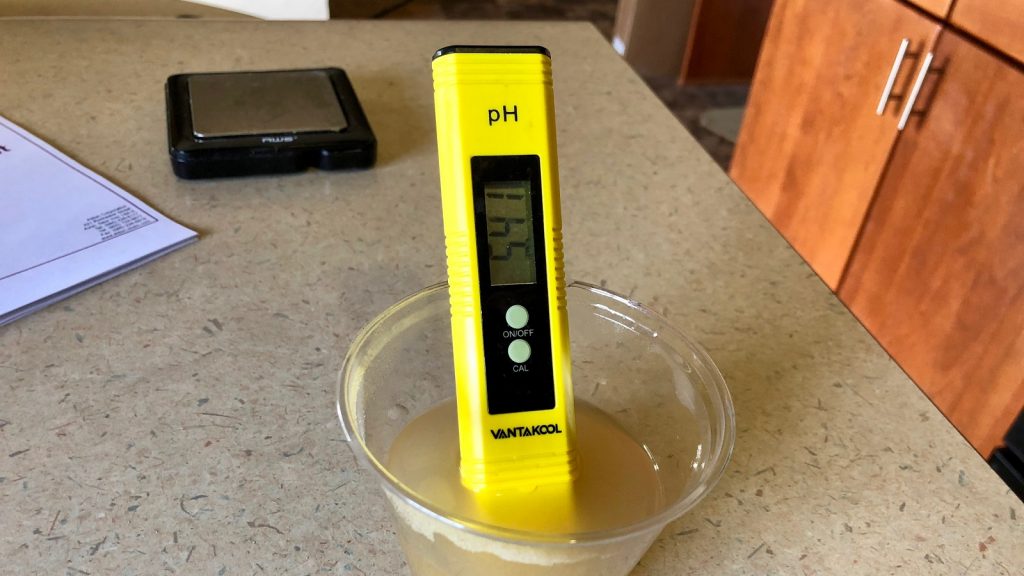
During the mash rests, I began heating the sparge water with my heat stick.
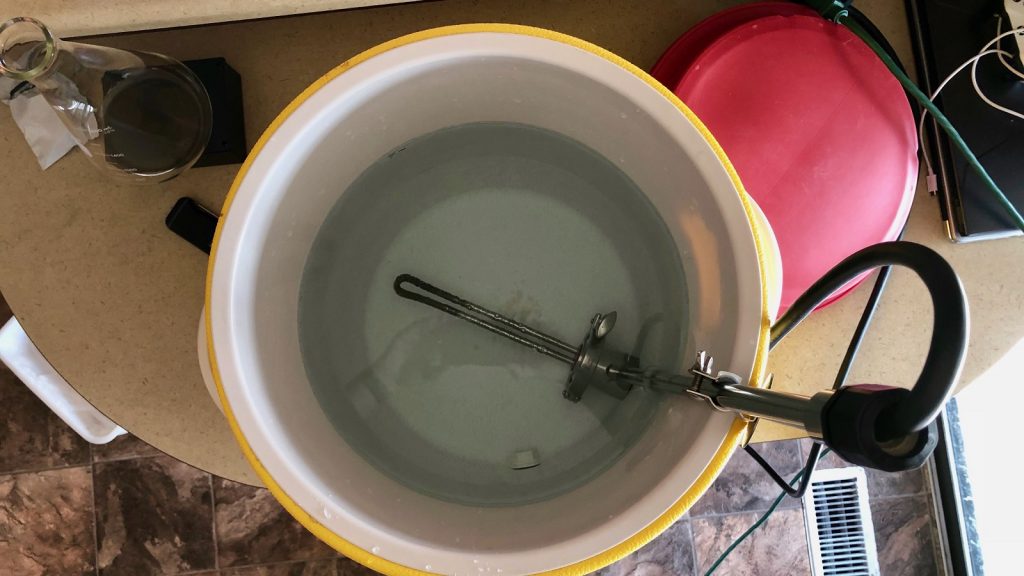
Sparging occurred after each 60 minute mash.

While the wort was heating, I weighed the hops, each batch receiving the same exact amount– I designed the beers to be as close as possible in terms of IBU without adding the variable of hop amount.
Both worts were boiled for 60 minutes with only 1 receiving hops in that time.
When the kettle hop wort was finished boiling, it was immediately chilled and racked to a fermentor while the hop stand wort boiled away.
Once the hop stand wort was done boiling, I turned the heat off, tossed in the entire hop charge and stirred intermittently over the next 23 minutes, the time BeerSmith predicted would lead to a similar IBU as the kettle hop batch.
The wort was then chilled and transferred to an identical fermentation vessel.
Hydrometer measurements showed both worts had achieved a similar OG.
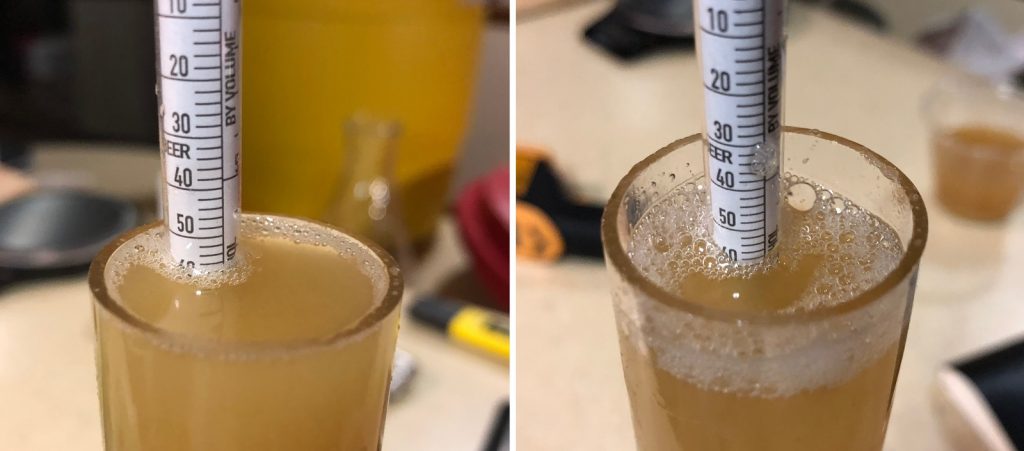
The worts were left in my chamber to finish cooling to my desired fermentation temperature, during which I made a vitality starter for either bacth with Imperial Yeast A01 Flagship.
I pitched the yeast 4 hours later then noticed airlock activity 12 hours after that. Following 4 days of active fermentation, I raised the temperature in the chamber to 72°F/22°C to encourage complete attenuation. With signs of fermentation absent a few days later, I took hydrometer measurements confirming both at reached the same FG.
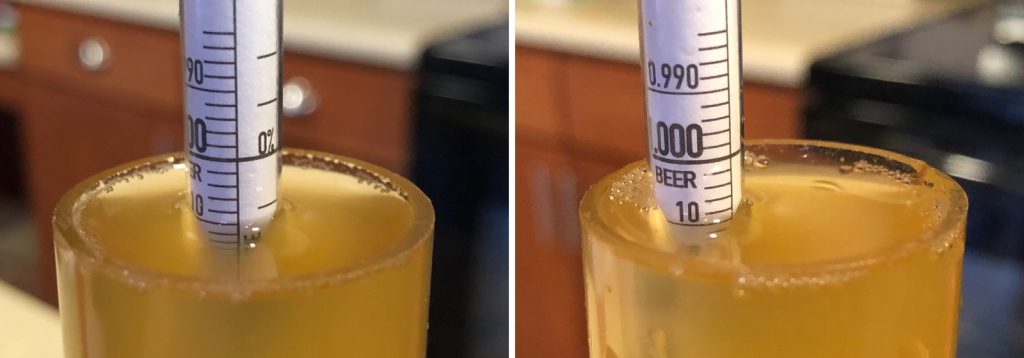
Both beers were then transferred to Torpedo kegs.
The filled kegs were placed in my cool keezer where the were burst carbonated and fined with gelatin. After a week of conditioning, they were ready to serve.

| RESULTS |
A total of 29 people of varying levels of experience participated in this xBmt. Each participant was served 2 samples of the kettle hop beer and 1 sample of the hop stand beer in different colored opaque cups then asked to identify the sample that was unique. At this sample size, 15 tasters (p<0.05) would have had to select the unique sample in order to reach statistical significance, though only 9 (p=0.67) made the correct selection, indicating participants were unable to reliably distinguish a Pale Ale hopped that was hopped at multiple points during the boil from one where all of the hops were added at flameout and steeped for 23 minutes.
Lab Data
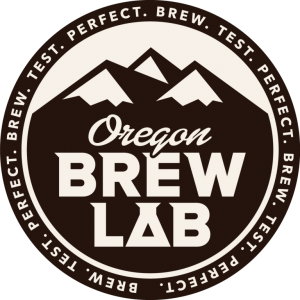 Curious as hell about claims the effect hop stands have on level of bitterness, I sent samples of each beer to Oregon Brew Lab for IBU analysis. Given the fact the hops were in contact with boiling wort longer in the kettle hop beer, I admittedly presumed it would come back with a higher IBU than the hop stand batch, and that both would be discrepant from BeerSmith’s predictions.
Curious as hell about claims the effect hop stands have on level of bitterness, I sent samples of each beer to Oregon Brew Lab for IBU analysis. Given the fact the hops were in contact with boiling wort longer in the kettle hop beer, I admittedly presumed it would come back with a higher IBU than the hop stand batch, and that both would be discrepant from BeerSmith’s predictions.
| Tinseth Formula | Rager Formula | Garetz Formula | Measured | |
| Kettle Hop | 40.5 | 50.3 | 40.5 | 33.5 |
| Hop Stand | 40 | 40 | 40 | 30.5 |
It doesn’t necessarily speak to the impact on flavor and aroma, but these lab results show bitterness between the beers was more similar than different. As predicted, lab measured IBU was lower than BeerSmith’s predictions for all formulas, though not by as much as I expected.
My Impressions: Despite feeling confident I’d be able to pick the odd-beer-out due to my knowledge of the variable, I went a lowly 2 for 8, which is just slightly worse than chance. My biased opinion prior to my triangle attempts was that the hop stand beer was a bit sweeter with a smoother overall bitterness than the kettle hop beer, which I thought had a sharper bitterness. Of course, this all jibes with expectations and I was unable to perceive the differences once blind to what I was drinking, leaving me to guess. Both beers were very good, though if I were to brew the recipe again, I’d probably do a blend of kettle hops and hop stand to really bump up the hop character.
| DISCUSSION |
In the not too distant past, it was commonly believed any hop addition that didn’t occur during the boil add very little if any bitterness to beer and was used primarily for aromatic purposes. The fact tasters in this xBmt couldn’t distinguish beers produced with hops added either solely during the boil or as a hop stand not only suggests bitterness doesn’t require a boil, but calls into question the age old adage about kettle hop timing for flavor and aroma as well.
On one hand, it makes sense these beers were as similar as they were since isomerization of alpha acids is known to occur at 175°F/79°C and the hops for the hop stand batch were tossed in immediately at flameout– even after the 23 minute stand, the wort was still over 190°F/88°C.
On the other hand, the effect of more traditional kettle hop additions is something ingrained in the minds of most brewers. How is that a beer with a portion of hops boiled for 60 minutes could end up tasting the same as one where the hops were steeped for a mere 23 minutes? Not to mention their awfully similar IBU levels as measured by a lab.
What surprised me the most, though, was the fact these beers weren’t different in terms of flavor and aroma, that a beer made with a single dose of various hop varieties was indistinguishable from one where the hops were added at points in the boil traditionally believed to impart flavor and aroma. Given the hop stand wort was not chilled prior to adding the hops, and considering the results of a prior xBmt on the topic, it would seem one could plausibly achieve desired character by making a single hop addition with 20 minutes left in the boil.
Hop stands have become a common method for brewers of hoppy beers known for imparting heaps of aroma, though this xBmt demonstrates it does more than just that. I certainly plan to continue messing around with this variable and am particularly interested in the impact of performing hop stands in cooler wort. Until then, I’ll comfortably question the “zero IBU” claims of some breweries.
If you have thoughts about this xBmt, please share them in the comments section below!
Support Brülosophy In Style!
All designs are available in various colors and sizes on Amazon!
Follow Brülosophy on:
FACEBOOK | TWITTER | INSTAGRAM
If you enjoy this stuff and feel compelled to support Brulosophy.com, please check out the Support Us page for details on how you can very easily do so. Thanks!

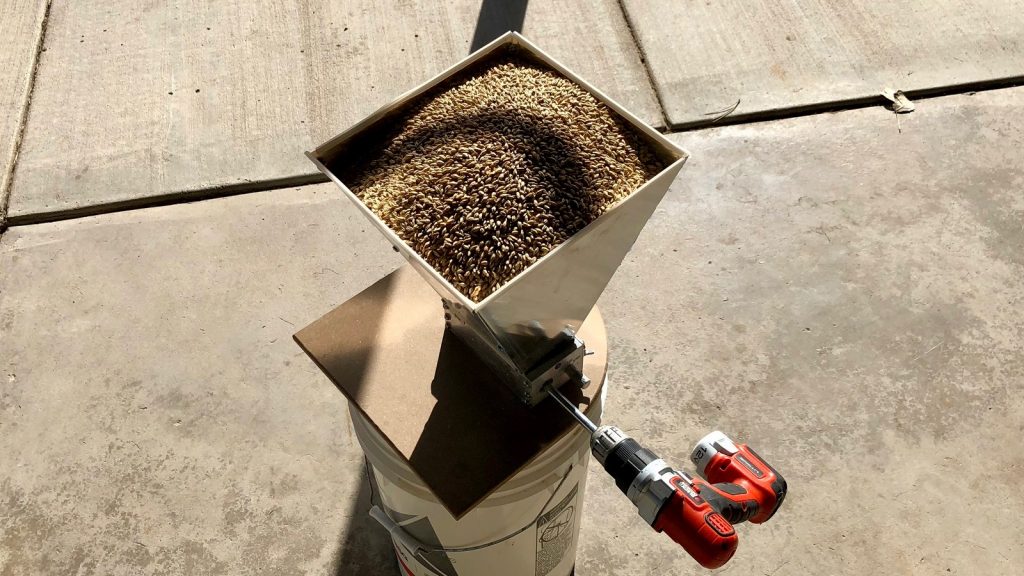
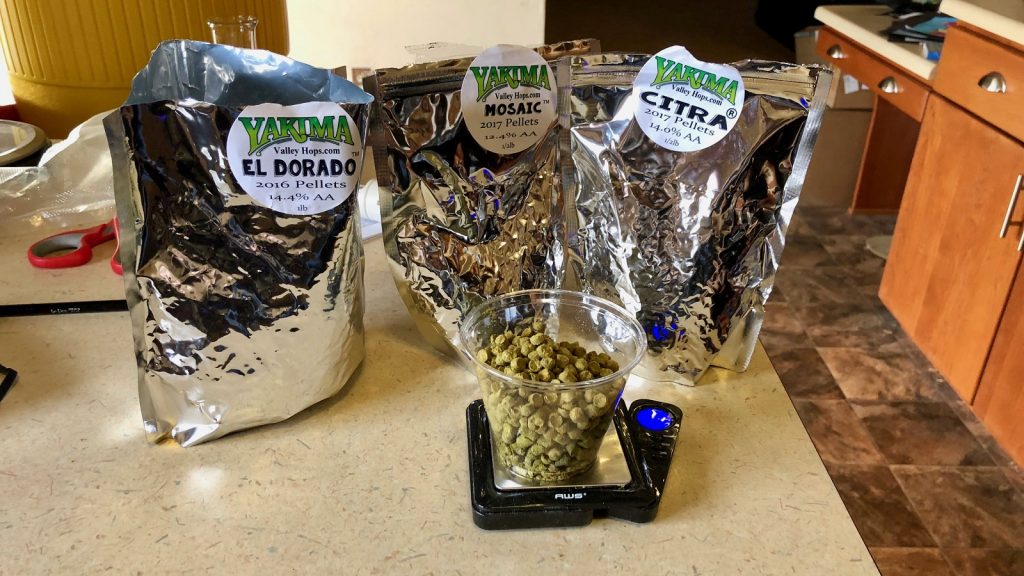


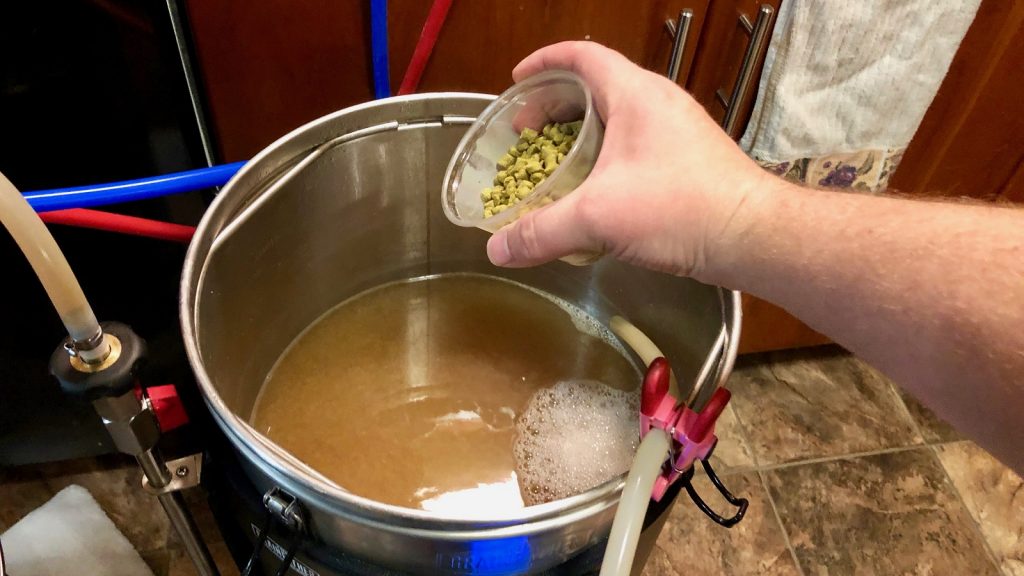

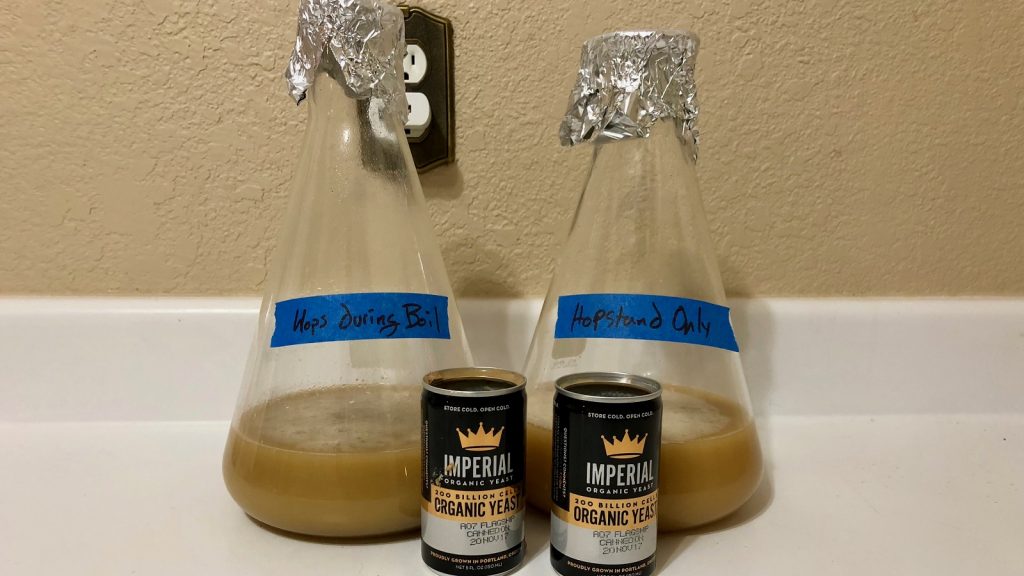












44 thoughts on “exBEERiment | Kettle Hop vs. Hop Stand In An American Pale Ale”
Similar to previous experiments around techniques for NEIPAs, the use of gelatin may be a larger factor then the variable you are testing. Since this would be abnormal for the style, I’m not sure what the results mean.
I suspect zero IBU IPAs are often made without hops added until the Whirlpool has dropped in temperature below 185F. I have noticed a significant difference using this method.
……and that’s why we love exBEERiments like this which separate spin from fact!! Zero IBU IPAs…. the notion even contradicts the style’s mythology not to mention it’s guidelines. Zero IBU beer sounds like Coolade to me in every respect.
I know the one zero IBU beer that I have had from a brewery (Structures in Bellingham, WA) had literally no hops added during the boil/whirlpool at all, with only a massive dry hopping. If it wasn’t 0 ibu it was close, it was an interesting beer to try but I don’t think I would brew it myself.
What about hitting a hopback just before the plate chiller with no air exposure?
I mean, I wouldn’t be mad at that.
This is worth a read in regards to those claims http://scottjanish.com/dry-hopping-effect-bitterness-ibu-testing/
Yes. Skip the fining if you want a difference in hop flavor/aroma
If only these techniques weren’t invented and extensively used on the west coast before NEIPA was a thing.
Love the experiment! ….but would like to see it done again where the hop stand only beer was cooled to 150 degrees before the hop charge was introduced. That in my opinion would more likely give you a zero (or close to it) IBU beer.
Trust me, this one is on the list!
The problem there it would be that people would guess it easily just because the difference in bitterness. I guess if they introduced the same amount of iBU in the hopstand beer at 60 minute would do the trick.
That’s exactly how I did this one, and would attempt to do any future tests.
What you’ve found is that, in this instance, a blend of different hop timings produced a similar effect to a single hop stand addition, and not that the hop timings make no difference at all.
Simple comparisons of ~40 IBU at 60 with no other additions, vs all at 30, 15, 5, etc., make the differences much more apparent.
Your (single) result is valid, but it shouldn’t be understood to mean that all hop schedules are arbitrary and can be ignored without consequence.
Interesting experiment and one that raises quite a few questions. The fact that no perceivable difference in aroma/flavour occurs suggests to me that hop stands are a waste of time and brewers might as well add all the hops during the boil and then proceed straight to chilling so as not to waste time with whirlpools or hop stands.
Was there any difference in clarity? The beers look similar but perhaps the hop stand is slightly hazier, though hard to say from a photo. If so, does the boil get ride of some of the haze material that would otherwise persist after a hop stand?
Dry hopping isn’t mentioned so presumably wasn’t done? If that’s right, I’d be interested to know how hoppy and aromatic these beers were.
Amazing the the IBUs were so similar, beersmith obviously doing a good job at predicting that.
Ya, the hop stand beer is slightly hazier, but not by much. Guessing more hop debris and oil stayed in suspension to add to that effect. We didn’t dry hop because we didn’t want to add an additional layer and have the potential of covering up the variable. Both beers were still full of hop flavor and aroma, despite skipping the dry hop. I enjoyed them, but think they’d be a bit better had I done a dry hop.
Consider my mind blown on this one. I’m not surprised tasters couldn’t tell a difference but the lab measurements being almost identical is crazy to me. I would like to read more xbrmts with lab measured IBUs for different hoping techniques to further know how much isomerization is really going on at different temperatures.
Have you used some of this information to adjust your beersmith settings? If so or if not, how might you adjust them to more accurately reflect real isomerization? Thanks for what you do as always.
There are more on the list! I haven’t messed with BeerSmith at all, and don’t plan to until I’ve conducted more xBmts to really dial it in. If you want to mess with/adjust your hop utilization settings they are found in Preferences, I believe. Not near a computer with BeerSmith installed.
Thank you for the interesting xbrmt! I love learning new things. I have a question about your keg method. When you transfer from the fermenter to the keg, how do you ensure you don’t overfill?
I used a grainfather and similar fermenter set up and I normally do an open transfer. Thanks in advance for your time.
That’s something I’m still learning how to gauge, and, yes, I’ve filled to the point where there was beer all over the floor. But the good news is if I overfill I pull a pint or two off the top, and it takes care of it.
One option I’ve heard a lot of people use is weighing the keg while you are filling it. It should weigh the same each time it’s filled.
I’ve been doing closed transfer for a while and have good success with the weighing method (just use my grain scale and keep it turned on while filling). One tip — you need to understand not only empty/full weights of each keg that you use, but the weight of things like connections as well. For example, I connect a spunding valve on the gas side, so the weight of that needs to be added. Also, depending on how the line on the liquid side is connected/supported, you may pick up a few additional oz/grams from that connection as well.
you could fill while weighting the keg.
For NEIPA I’ve experimented with my only hops addition being at whirlpool (using a pump) once I’ve chilled to 175 degrees. I hold at 170-175 for about 25 minutes. This imparts some bitterness but much less than at higher temp. You may want to experiment with this method since 175 is the temp for isomerization of alpha acids.
I do almost thé same for my professional beers : chilling to 185 just after the flameout, put the hops and stir for 30 mn (naturally it goes down to 170)
Sorry for my poor american, I’m French 🙂
So we can get similar beer by making the small effort to add hops at different stages of the boil or add 20-30 minutes to our brew day? Surely the popularity of hop stands has come about due yet it’s ability to extract less bitterness which would require dropping the temperature of the wort before the total hop charge was added. I guess we can conclude that it may be important to partial chill before a hop stand
Why boil for 60 minutes if you are going to do the 20-30 minute brew day? If using this method, just boil for 20 minutes and then start your hop stand for 20-30. Brew day would actually shorten, right?
sorry, meant 20-30 minute hops stand in stead of brew day in the first sentence….
Boom!
And I get this two days after a brew session with a complicated hop schedule, one in which I took advantage of Alexa’s ability to have multiple named timers… 🙂
Great experiment! Thanks for passing along.
I have often allowed my hops to steep long after flame-out. Since I do not have a cooling apparatus, I let the kettle cool over several hours, and then drain to the fermenter. I generally leave the hops in for that entire time. Maybe I’ve been a little bit of a rebel since I generally don’t follow recipes and traditions.
What if you lower the temperature below 79 ºC before starting hop stand? We might get 0 IBU (in theory).
If you lower your temps to 160-165 before adding the whirlpool/ hop stand addirion, you will see a big difference. Inmho at least.
They tried that already. https://brulosophy.com/2017/07/31/the-hop-stand-flameout-vs-120f-49c-exbeeriment-results/
No difference.
Yeah. I don’t do my whirlpool until under 160F. And I keep cooling. I don’t want it to send the hop oils out of the solution.I never really understood keeping it at one temp. My cooling is slow process so maybe that is it. Can you try an exbeeriment where in BEER A hops are added in whirlpool at one temp, and BEER B hops are added at the same temp and then cooled? I think there would be some difference.
OR maybe I should do bitter hop at 30 mins. And dry hop only…
Science! I’m more for the stouts but do try to play with hop additions. I’d like to see a few more of these with a few more altered variables to see if the hop addition timings are really just a fallacy.
Do I understand that boil is no longer necessary?
That would be a misunderstanding of these results.
I just read “Yeast”, Brewing elements series. There is a paragraph on page 107 that states yeast has impact on final IBU of the beer.
That says, maybe you should send wort before fermentation for IBU analysis. Although the beer is what we really care and the fermentation conditions are identical, measuring the finished wort seems might eliminates a unknown factor.
Let me quote the paragraph to save you time:
”
Yeast strain and condition also impact the hop character of a beer. For example, comparisons of White Labs California Ale(WLP001) and English Ale (WLP002) fermentation at the same pitching rate and temperature show the former results in a higher finished IBU level than the latter. Many factors determine the final IBUs of a beer, and yeast are a major player. Differences in the cell surface, cell size, pitching rates, growth rates, and flocculation characteristics all play a role in determining the amount of isomerize hop acids that make it through to the finished beer.
“
I think the next version of this experiment should be to skip the boil completely. At sparge temps you are well over pasteurization temps. So why not just jump to your bulk hopstand and be done. Boy, would that save time raising it to boil only to cool it. If you were worried about bittering/60 min maybe you could replace with a higher aa that hop.
I’d love to hear your take on this idea of mine. Based on my understanding of extract brewing there really is no need to boil DME/LME for 60 min to remove the chances of off-flavors since that was done already in the extract process. Combined with this research would you conclude that I could steep grains, mix in the DME, bring to a boil, turn off the burner and do a hop stand for 25 minutes and come up with great tasting beer with the same hop profile? I think I’ll give that a shot!!
That is truly an fascinating result that confounds some of our ingrained brewing dogma. Since I now brew using a Braumeister – not dissimilar to your Grainfather – I would be most interested to know what the effect would be of only that hop addition at flame-out but activating the built-in cooling coils at the same time. I am certain the result would be quite different, but one is always a little chary of letting the wort stand without cooling for any length of time. But you did indicate that the temperature of the wort remained over 88 C for 23 minutes, so I guess it is unlikely that any nasties could gain a foothold in the wort. Still, it would be interesting to know what flavours the hopping might impart even if cooling was commenced soon after flame-out. Any thoughts?
Regards,
Ian
I’m wondering why you always fine your brew experiments with gelatin? That could maybe affect the results, and besides, some of us don’t like animal products in they’re beer!
Someone above mentioned temperature and they’re spot on. This is chemistry. You either have enough kinetic energy to isomerize or you don’t. 185 or less should be low enough to stop isomerization. Redo this experiment and don’t add kettle hops until lower than 180 and you’ll see different results.
Hey Jason, bit late to the party but I’ve just come across this article. I’m curious to know what you plugged into BeerSmith to generate your calculated IBU? I do something similar but never sure the best way to plug it in as the wort does cool over the duration of the hop stand.